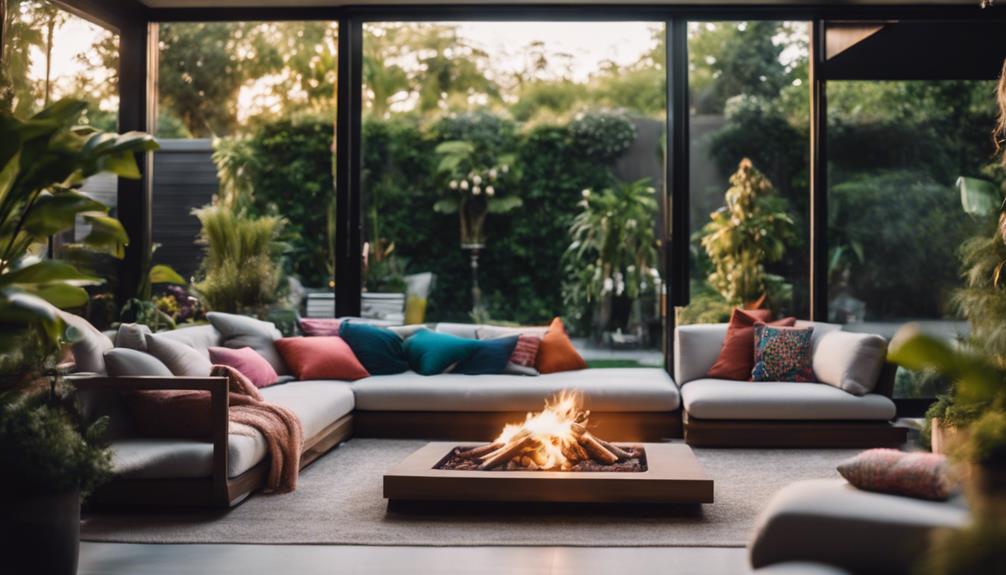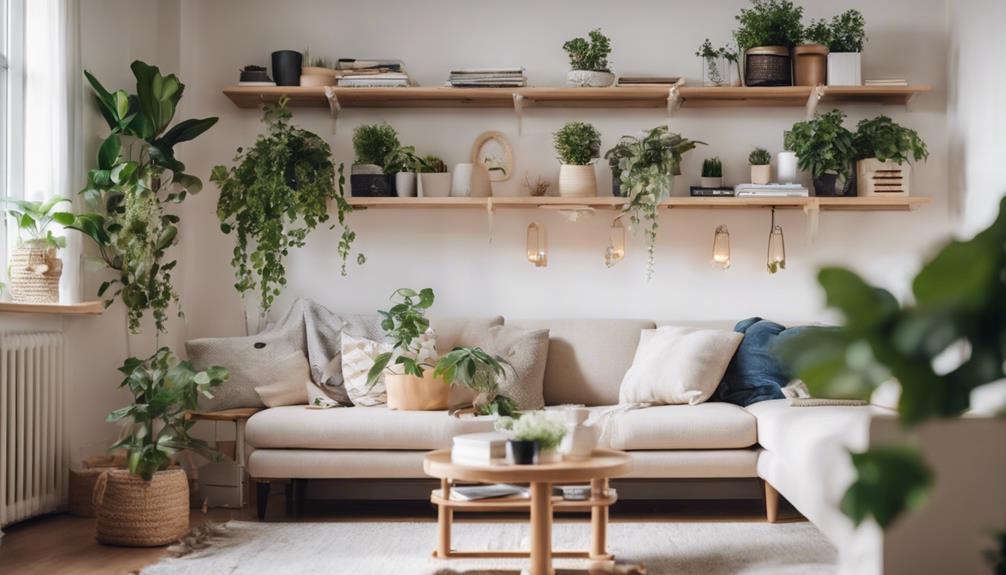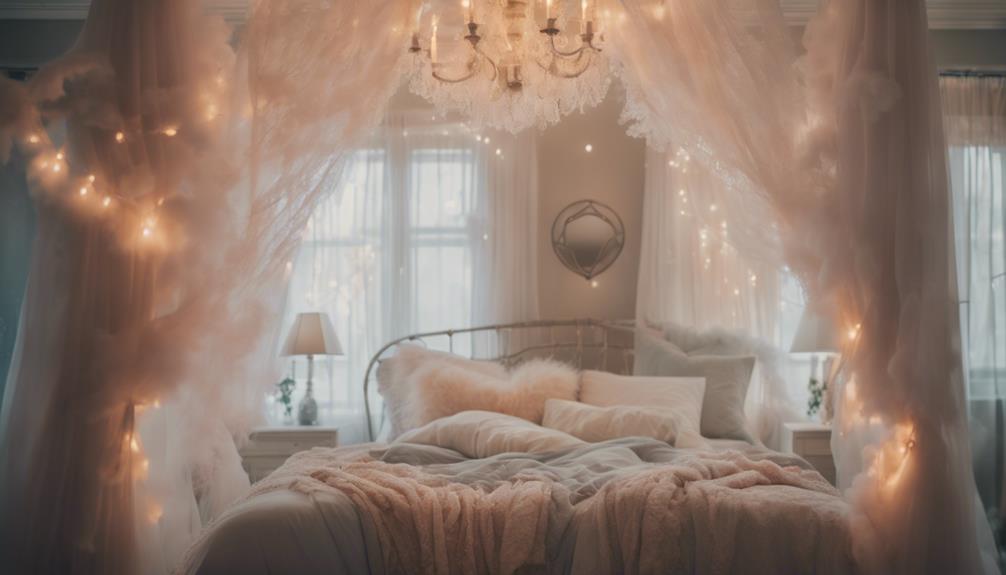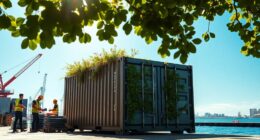To create a cohesive flow between your indoor and outdoor living areas, start by evaluating the sizes and layouts of both spaces. Use a unified color palette and matching materials to guarantee a seamless changeover. Maximize natural light with large windows and thoughtful furniture arrangement, framing beautiful views. Incorporate functional outdoor zones with comfortable furniture and clear pathways. Consider climate comfort by adding shade and heating options as needed. Finally, blend lighting for a warm atmosphere. By following these tips, you'll enhance the overall connection between spaces and discover even more ways to elevate your home.
Key Takeaways
- Assess both indoor and outdoor spaces for size, layout, and functionality to ensure they complement each other effectively.
- Use a unified color palette and consistent materials to create a seamless transition between indoor and outdoor areas.
- Maximize natural light with large windows, reflective surfaces, and strategic furniture placement to enhance ambiance.
- Design functional outdoor areas with distinct zones and comfortable furnishings to improve usability and connection to indoor spaces.
Assess Your Living Spaces
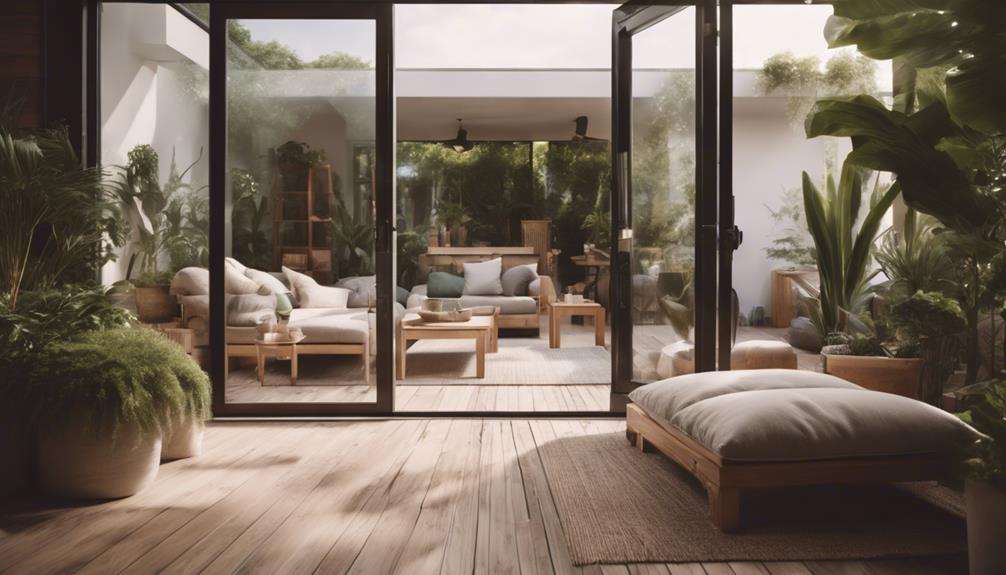
To create a cohesive indoor and outdoor living experience, you should start by evaluating the size and layout of both spaces to see how they can complement each other.
Examine the functionality of each area, noting how you currently use them and what you want to achieve. Identify any architectural features like windows and doors that may affect the layout and flow between your indoor and outdoor spaces.
Look for potential connecting areas, such as patios or sunrooms, that can act as connectors, enhancing the overall aesthetic. These spaces can help bridge the gap, creating a seamless connection.
When considering materials, use matching colors and textures throughout to foster a cohesive flow.
Don't forget about lighting options; they're essential for enhancing both environments and can create inviting atmospheres.
Incorporating natural elements like plants can also unify your design, bringing life to the space.
Design for Cohesion
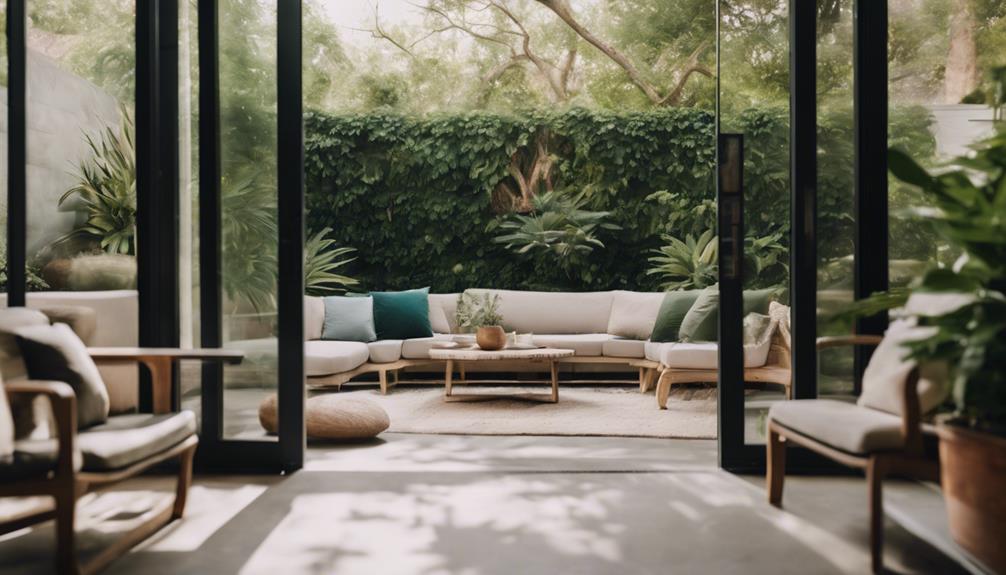
To create a harmonious connection between your indoor and outdoor spaces, focus on a unified color palette that flows seamlessly.
Think about using the same materials for both areas to enhance continuity, and arrange your furniture thoughtfully to mirror each space.
These design choices won't only elevate aesthetics but also foster a sense of comfort and cohesion throughout your home.
Unified Color Palette
Creating a unified color palette bridges the gap between indoor and outdoor living areas, enhancing the overall cohesion of your space. A well-chosen color scheme fosters a cohesive environment, making both areas feel interconnected. Here's how to achieve that:
- Choose a Maximum of Three Primary Colors: Select similar or complementary shades that can seamlessly flow from indoors to outdoors. This keeps the design simple and clear.
- Incorporate Neutral Tones: Use neutral tones as a base for your palette. They can balance bold colors and provide a calming backdrop that enhances visual connection between spaces.
- Add Select Accent Colors: Strategically incorporate accent colors to highlight specific design elements or focal points. These should complement your overall theme, reinforcing the continuity between indoor and outdoor aesthetics.
Seamless Material Transitions
A cohesive design extends beyond color choices, as seamless material shifts play a key role in merging indoor and outdoor living areas. To achieve a seamless connection, consider using matching flooring materials, like extending hardwood or porcelain tiles from your indoor space to the outdoor area. This creates a strong visual flow and enhances continuity across both environments.
Selecting a cohesive color palette is essential; stick to no more than three primary colors paired with neutral tones for a unified aesthetic. Incorporating natural elements such as stone, wood, and plants in both spaces reinforces harmony and the connection between indoors and outdoors.
Architectural details, like columns or beams that mirror your home's interior design, help blur the boundaries of your indoor-outdoor living space. Additionally, using consistent textures in furniture and decor—think weather-resistant fabrics that reflect your indoor choices—creates a unified look and feel.
Thoughtful Furniture Arrangement
Thoughtful furniture arrangement can transform your indoor and outdoor spaces into a cohesive environment that encourages flow and connection. To achieve this, consider the following strategies:
- Create conversation zones: Position seating areas that seamlessly extend from your living room to the outdoor patio, promoting social interaction and enhancing the cohesive flow between spaces.
- Use complementary colors: Select furniture in colors and materials that complement each other, establishing a unified aesthetic that visually links your indoor and outdoor areas.
- Strategically orient furniture: Arrange pieces to frame outdoor views from inside and vice versa, creating a seamless visual connection that enhances the overall ambiance.
Additionally, incorporate multifunctional furniture, like benches with storage, to maximize utility without sacrificing style.
This approach not only enhances movement but also guarantees that your spaces remain comfortable and inviting.
Maximize Natural Light
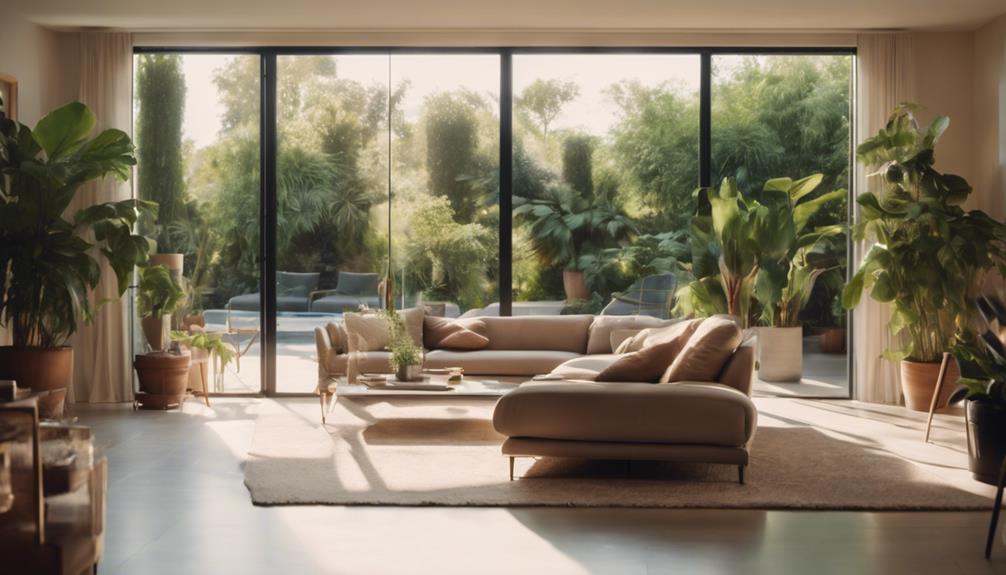
To maximize natural light, you should consider installing large windows and glass doors that create a seamless connection between your indoor and outdoor spaces.
Enhancing your outdoor seating areas by positioning them for ideal sunlight can brighten both environments.
Additionally, framing scenic views with your furniture can draw in more light and elevate the overall ambiance of your living areas.
Utilize Large Windows
Maximizing natural light in your home is easily achieved by incorporating large windows that invite the outdoors in and brighten your living spaces. By choosing the right windows, you can create a cohesive flow between your indoor and outdoor areas while enhancing your overall living experience. Here's how:
- Floor-to-Ceiling Windows: These not only frame unobstructed views but also create the illusion of expanded space, making your interiors feel more open and inviting.
- Strategic Placement: Position your large windows to favor east, west, or southern exposures. This guarantees maximum exposure to natural light throughout the day, boosting mood and productivity.
- Bi-fold or Sliding Glass Doors: These designs promote seamless shifts between your indoor and outdoor areas, enhancing your connection with nature and allowing for improved ventilation.
Incorporating large windows can greatly enhance natural light flow, reduce the need for artificial lighting, and provide fresh air circulation.
Enhance Outdoor Seating
Positioning your outdoor seating near large windows or glass doors lets natural light flow seamlessly into both your indoor and outdoor spaces, brightening the entire area. To truly enhance your outdoor seating, consider the following design elements:
| Design Element | Benefits |
|---|---|
| Translucent Materials | Allows light to filter through while maintaining privacy. |
| Reflective Surfaces | Bounces natural light, creating a more inviting environment. |
| Strategic Layouts | Frames landscape views and maximizes natural light intake. |
Using translucent materials like acrylic or mesh not only keeps the atmosphere light and airy but also adds a modern touch. Opt for light-colored or reflective surfaces in your outdoor seating to enhance the natural light and create a spacious feel.
Additionally, strategically placed mirrors or reflective decor can amplify the effect of natural light, visually expanding your seating area. By designing layouts that invite you to enjoy the landscape views, you'll create a cohesive flow between your indoor and outdoor living spaces that feels bright, welcoming, and connected.
Frame Scenic Views
Framing scenic views with large windows and multi-panel glass doors instantly brightens your living space, creating an enchanting connection between indoors and outdoors. By maximizing natural light, you not only enhance your indoor spaces but also create a seamless passage to your outdoor living space.
Here are three effective ways to frame those views:
- Position outdoor seating areas: Place them near large glass doors to extend indoor natural light outdoors, making both spaces feel cohesive.
- Optimize exposure: Favor east, west, or southern-facing windows to capture the most natural light throughout the day, enhancing your overall experience in both areas.
- Strategically orient furniture: Arrange your indoor furniture to frame scenic views, encouraging a visual connection and fluid movement between your indoor and outdoor spaces.
Additionally, consider incorporating translucent materials for window treatments that provide privacy without sacrificing brightness. This way, you maintain unobstructed views while ensuring a consistent flow of light.
Create Transitional Doorways
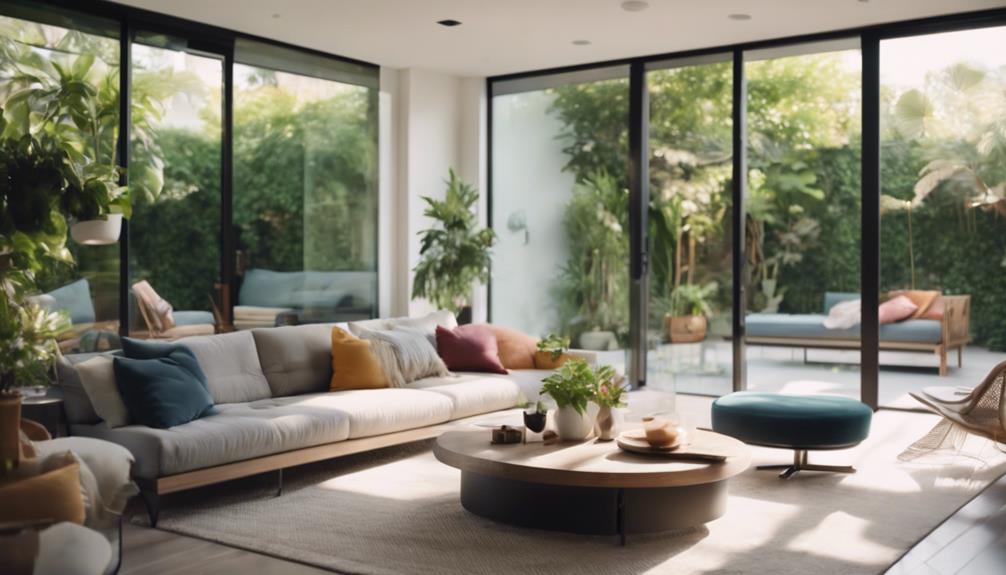
To create a seamless connection between your indoor and outdoor living spaces, consider replacing standard doors with accordion, pocket, or bi-fold options that enhance flow and invite natural light. These connecting doorways not only allow for free movement but also visually and physically unify your spaces, creating a cohesive atmosphere.
By incorporating floor-to-ceiling multi-panel glass doors, you can maximize natural light, blurring the lines between indoors and outdoors. This enhances visual connectivity, making your living areas feel more expansive and inviting. Extra-large pivoting doors offer a grand entrance that further elevates this design, promoting an effortless change.
When designing these doorways, pay attention to the architectural details. Confirm they mirror the style of both your indoor and outdoor spaces for a unified look. This thoughtful integration will enhance the overall aesthetic and functionality, making your home feel more connected.
Ultimately, the right connecting doorways can transform your living experience, allowing you to enjoy the beauty of your outdoor environment from the comfort of your indoor spaces. With careful consideration, you can achieve a harmonious flow that enhances your lifestyle.
Build Functional Outdoor Areas
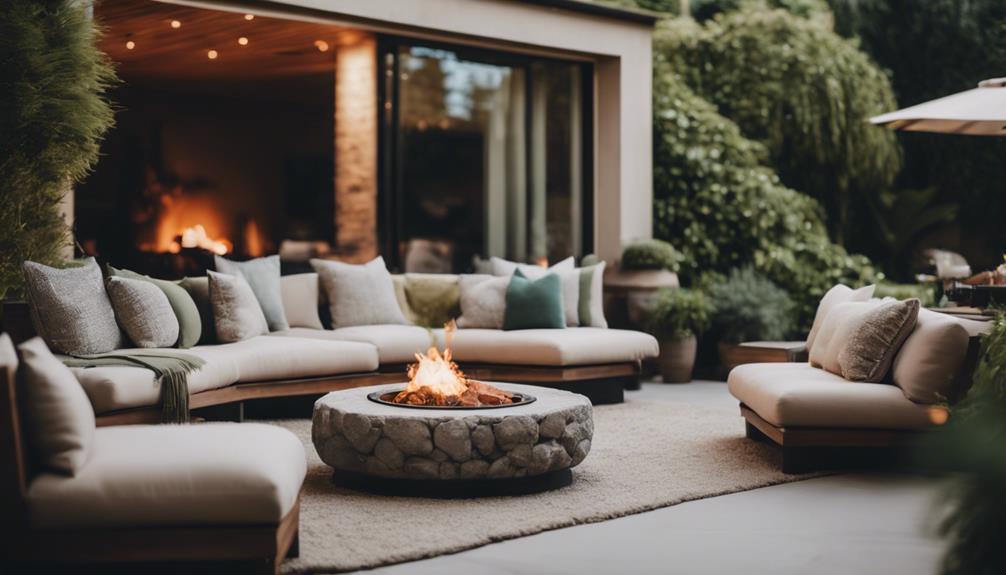
Establishing distinct zones in your outdoor space for dining, lounging, and cooking boosts functionality and guarantees each area meets its specific purpose. To create an inviting and practical outdoor living space, consider the following:
- Designate Areas: Clearly define your dining area, cozy seating zones, and cooking space. This separation enhances usability and creates a seamless flow throughout the area.
- Use Multi-Purpose Furniture: Invest in weather-resistant materials for outdoor furniture, like storage benches or foldable tables. This allows you to adapt to various gatherings or activities without cluttering your space.
- Maintain Clear Pathways: Verify clear pathways between zones for easy movement. This not only improves accessibility but also enhances the overall aesthetic of your outdoor areas.
Creating conversational zones with strategic seating arrangements encourages interaction among guests.
Consider Climate and Comfort
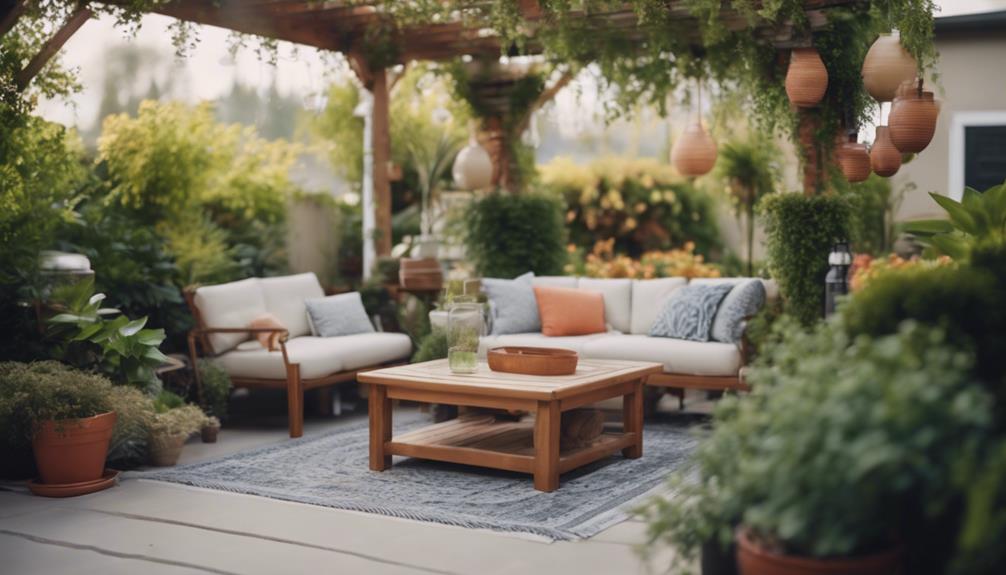
Creating functional outdoor areas goes hand in hand with considering climate and comfort, as these factors play a significant role in how you enjoy your space year-round.
First, assess your local climate conditions to choose materials and furniture that can withstand weather extremes. In colder regions, adding outdoor heating elements like fire pits or patio heaters can extend usability during chilly months, ensuring you can enjoy your outdoor living areas even in winter.
For warmer climates, integrating shade structures such as pergolas or umbrellas provides essential relief from direct sunlight while enhancing airflow. Additionally, incorporating natural elements, like water features, can help regulate temperature and create a soothing atmosphere, making your outdoor space inviting regardless of the season.
Designing with adjustable features, like retractable awnings and movable furniture, allows you to adapt your area to varying weather conditions. This flexibility means you'll achieve maximum comfort year-round, making your outdoor oasis a true extension of your home.
Enhance With Lighting and Decor
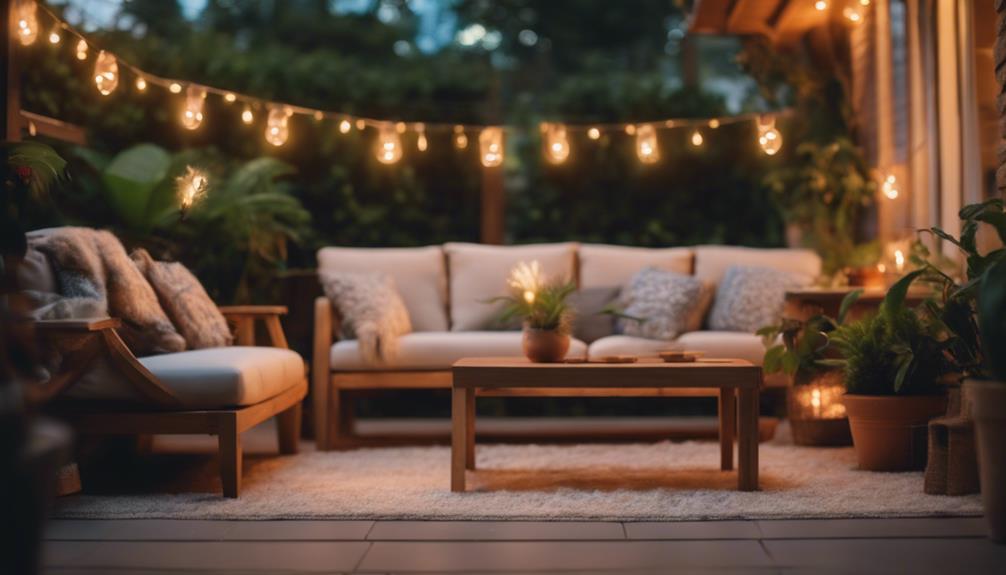
Enhancing your indoor and outdoor living areas with thoughtful lighting and decor transforms the atmosphere, making it inviting for gatherings and relaxation.
Outdoor lighting can transform your space, blurring the lines between the indoors and outdoors while creating a cohesive flow. By strategically using a mix of ambient, task, and accent lighting, you can enhance the aesthetic and functionality of both areas.
Here are three ways to elevate your lighting and decor:
- Install Solar-Powered LED Lights: These energy-efficient options are easy to install and complement outdoor aesthetics while ensuring safety at night.
- Incorporate Adjustable Lighting Solutions: Use dimmers or motion sensors for personalized ambiance, allowing you to set the mood for any occasion.
- Highlight Architectural Features: Position lights to accentuate key elements of your home and landscape, creating a seamless shift between spaces.
Consider adding string lights or lanterns for a cozy touch that encourages evening use.
Frequently Asked Questions
How Do You Make an Indoor Outdoor Flow?
To create an indoor-outdoor flow, you'll want to maximize natural light with large windows and sliding doors, use complementary materials, and design open spaces that encourage movement and interaction between your indoor and outdoor areas.
How Do You Connect Indoor and Outdoor Space?
To connect indoor and outdoor spaces, use large glass doors for easy access, extend flooring materials for consistency, and coordinate colors and textures. Position furniture to frame views and enhance the overall aesthetic appeal.
How to Design Indoor Outdoor Living Space?
To design your indoor-outdoor living space, incorporate large windows for natural light, choose complementary materials, create multifunctional zones, and add plants for a relaxing atmosphere. This approach enhances connectivity and comfort in both areas.
What Are Some Design Considerations Related to the Outdoor Living Area?
When planning your perfect outdoor paradise, prioritize purposeful zones, pick practical materials, and promote pleasant pathways. Don't forget lighting layers and lovely landscaping; they'll elevate your space and enhance the overall experience for everyone.
Conclusion
By seamlessly blending your indoor and outdoor spaces, you'll create a living experience that feels like a never-ending vacation!
Embrace the beauty of nature and let it flow into your home.
With thoughtful design, functional areas, and the right lighting, you'll transform your environment into a harmonious oasis.
So go ahead, take the plunge, and watch as your living areas come alive in a spectacular dance of comfort and style!
